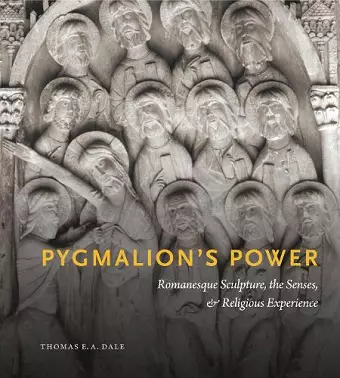Pygmalion’s Power
Romanesque Sculpture, the Senses, and Religious Experience
Format:Hardback
Publisher:Pennsylvania State University Press
Published:25th Oct '19
Currently unavailable, and unfortunately no date known when it will be back

Pushed to the height of its illusionistic powers during the first centuries of the Roman Empire, sculpture was largely abandoned with the ascendancy of Christianity, as the apparent animation of the material image and practices associated with sculpture were considered both superstitious and idolatrous. In Pygmalion’s Power, Thomas E. A. Dale argues that the reintroduction of architectural sculpture after a hiatus of some seven hundred years arose with the particular goal of engaging the senses in a Christian religious experience.
Since the term “Romanesque” was coined in the nineteenth century, the reintroduction of stone sculpture around the mid-eleventh century has been explained as a revivalist phenomenon, one predicated on the desire to claim the authority of ancient Rome. In this study, Dale proposes an alternative theory. Covering a broad range of sculpture types—including autonomous cult statuary in wood and metal, funerary sculpture, architectural sculpture, and portraiture—Dale shows how the revitalized art form was part of a broader shift in emphasis toward spiritual embodiment and affective piety during the late eleventh and twelfth centuries.
Adding fresh insight to scholarship on the Romanesque, Pygmalion’s Power borrows from trends in cultural anthropology to demonstrate the power and potential of these sculptures to produce emotional effects that made them an important sensory part of the religious culture of the era.
“The eleventh and twelfth centuries in Western Europe witnessed a level of sculptural production unequaled since antiquity. Thomas Dale offers a fresh and compelling account of this phenomenon, focusing on how the very materiality of Romanesque sculpture helped patrons and audiences make sense of their world. This book will be of wide interest to historians of medieval art, as well as to anyone interested in the problem of the senses.”
—Kirk T. Ambrose, author of The Marvellous and the Monstrous in the Sculpture of Twelfth-Century Europe
“In Pygmalion’s Power, Thomas Dale replaces the outdated master narrative of Romanesque sculpture with a brilliant new history of materials, meanings, and functions. Considering both the normative—portraiture and the ideal nude—and the ‘disruptive other’ of the monstrous and the lustful, he delves into issues of the body as model, as admonition, and even as musical instrument to be played rightly. Finally, characterizing the church itself as body, he demonstrates how sculpture could activate the senses and allow perception of the divine.”
—Cynthia Hahn, author of Strange Beauty: Issues in the Making and Meaning of Reliquaries, 400–circa 1204
“The reasons for sculpture’s ‘revival’ and its vital eventual role in the visual culture of the Middle Ages have long dogged the narrative of medieval art. Dale offers an original and thought-provoking rewriting of the problem by exploring sculpture’s new spiritual embodiment, decisively showing how viewers’ psychological investment in sculptural objects—stone sculpture in a cloister, reliquaries in crypts, carved wooden Crucifixions—animated the works and gave them meaning. Pygmalion’s Power represents a significant reorientation for medieval sculpture studies and offers a welcome challenge to older orthodoxies.”
—Robert A. Maxwell, author of The Art of Medieval Urbanism: Parthenay in Romanesque Aquitaine
“This is a major contribution to understanding Romanesque art. The so-called Pygmalion effect should be presented in every course on Romanesque art.”
—D. K. Haworth Choice
ISBN: 9780271083452
Dimensions: 254mm x 229mm x 29mm
Weight: 1588g
304 pages